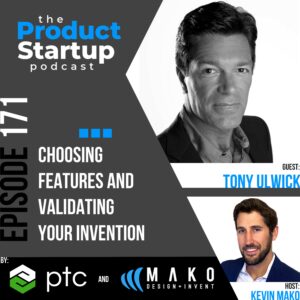With Tony Ulwick, Author & CEO
Hosted by Kevin Mako, President of MAKO Design + Invent

Tony Ulwick is the CEO of Strategyn, a firm that has provided strategic consulting services to high-growth innovative hardware companies since 1991. Ulwick began his career at IBM as a design for a manufacturing engineer. He is also an accomplished author with two published books and has twice contributed articles to the Harvard Business Review. In his upcoming presentation, Ulwick will share essential insights for inventors, startups, and small manufacturers on creating hardware products that meet customer demand, understanding consumer buying behavior, and validating invention ideas using additive manufacturing techniques in the market.
Today you will hear us talk about:
- What are the steps to creating desirable products and validating invention ideas?
- Identify the wants and needs of your customers.
- What motivates a customer to purchase your hardware product?
- Consider the market as a group of individuals with a specific job that can be accomplished through a hardware invention.
- Understand the customer’s requirements to fulfill the job at hand.
- Define the desired outcomes that your hardware product can deliver.
- Focus on designing hardware products that are faster, more predictable, or deliver better results to meet the customer’s needs.
- Prioritize the most unmet needs of the customer.
- Address the most underserved outcomes of a job to achieve significant growth.
- Identify the minimum number of features required to cater to the largest segment of customers.
- Clearly define the necessary features for your hardware startup so you can assess if there is interest in your invention.
- Begin with the feature you desire and work with the customer to refine it through product testing.
- Evaluate the importance of a feature to the customer and their satisfaction with current solutions.
- If you confirm the opportunity, create a compelling product offering that meets customer needs.
- Short-run manufacturing can help with validating invention ideas at a low cost and provide insight into market scalability.
- Emphasize one critical feature in product development.
- Achieving a 15% or more improvement can result in an exceptional product.
- Determine the underserved needs in the market.
EPISODE HIGHLIGHTS
- 1:15 – What consumer hardware product features are critical for great product market fit.
- 3:00 – What inputs do we need from customers in order to know what features are needed
- 4:00 – Start by defining a market. Figure out what your customers want.
- 4:30 – Look at product development through the lens of the customer getting a job done.
- 5:30 – Define customer needs, and desired outcome statements.
- 6:00 – What can you measure and control in your hardware customer’s success
- 6:30 – How do get the job done faster, more predictably, and/or with better quality result.
- 7:45 – If you are going to add a feature to a product, you want it to address a core end-customer need, but also, the most unmet need is most important to address.
- 9:20 – A hardware startup has limited resources, so it’s critical to be very careful to design only the most efficient features, and not to feature creep.
- 9:35 – You can not be everything to everyone, and you cannot have every feature, especially with your first consumer product launch.
- 10:45 – Hardware founders are inundated with feature ideas; however, you have to ensure you are very focussed on which features you actually choose to avoid product development feature creep.
- 12:00 – If you find that potential customers aren’t really that interested in the additional features you are adding, then clearly it’s not worth adding those features to the product.
- 12:30 – Get short-run production done so that you can get a few units into real users’ hands, that those users have paid for, and then collect clear feedback on your features.
- 12:45 – Your first version of a product should be high quality but with fewer features so that you can focus on your core features for the market.
- 13:00 – Quality is so important for hardware, so sacrifice features and use the development budget to ensure the few features you have are high quality.
- 13:45 – As a startup, it will take you a while to capture all of your worldwide total addressable markets, so you might as well be laser-focused on your features until you feel like you have saturated the market.
- 15:00 – Find invention features that are really important to your customer, but not well satisfied with existing product solutions.
- 15:15 – If you can make a product 15% better than existing custom options, you have a world-class advantage.
EPISODE LINKS
Tony Ulwick Links:
The Product Startup Podcast Links:
https://www.ProductStartup.com/
Instagram | LinkedIn | Facebook Page | Facebook Group | Pinterest | Twitter | YouTube
PTC Links:
https://www.ptc.com/
OnShape | Creo
Mako Design Links:
https://www.makodesign.com/
YouTube | Instagram | LinkedIn | Facebook | Pinterest | Twitter
Kevin Mako Links:
Instagram | LinkedIn | Quora | Facebook | Twitter
Partner: PTC’s best-in-class software solutions Onshape: The only cloud-native product development platform that delivers full-featured computer-aided design (CAD), integrated product data management (PDM) and enterprise analytics in a single system, and Creo: 3D CAD solution that provides designers with the most innovative tools to build better products faster, such as generative design, additive manufacturing, real-time simulation, IIoT, and augmented reality.











